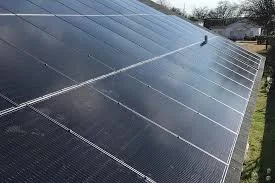- Reuters
- 28 Minutes ago
Government slashes solar panel benefits by 63pc with new net metering policy
-
- Web Desk Karachi
- Mar 14, 2025

ISLAMABAD: The government enacted significant changes to the net metering policy on Thursday, leading to a 63 percent reduction in benefits for new solar panel owners.
These changes mandate that these owners purchase electricity from the national grid at rates exceeding 550 percent of what they receive for selling power back to the grid.
Under the revised policy, rooftop solar panel owners will be compensated at Rs10 per unit for the electricity they sell but will have to purchase power at the current approximate rate of Rs65 per unit.
This situation creates a stark price disparity, resulting in solar energy consumers paying substantially more for electricity compared to what they earn from their solar contribution.
The revised terms will also apply to existing rooftop solar panel users once their contracts, which last a maximum of seven years, conclude. The Economic Coordination Committee (ECC) of the Cabinet approved this major policy adjustment.
The ECC, led by Finance Minister Muhammad Aurangzeb, made amendments to the Net Metering Regulations after the Power Division tabled the critical policy change as an additional agenda item, limiting the opportunity for thorough discussion among committee members before the meeting.
This new regulation eliminates the practice of offsetting solar-produced electricity against the units drawn from the national grid, which the finance ministry claims is to alleviate the financial burden on non-solar consumers.
Are solar panels becoming a headache for the govt?
The ECC also granted the Power Division the authority to propose guidelines for NEPRA, awaiting Cabinet approval, to reform the regulatory framework.
The revisions reduce the buyback rate for solar panel owners from Rs27 per unit to Rs10 per unit, dramatically decreasing their earnings. Concurrently, electricity purchased from the national grid will reflect actual market prices, currently between Rs65 and Rs70 per unit, inclusive of taxes.
The government justified this policy alteration by asserting that solar consumers create an additional burden of 90 paisa per unit on non-solar consumers. This contrasts with the government’s lesser concern about Rs18 per unit attributed to idle capacity payments or the estimated Rs600 billion lost annually from theft and under-recovered bills.
Consequently, the ECC not only endorsed the buyback rate cut but also empowered NEPRA to amend the rate in the future without requiring government consent.
The updated pricing mechanism establishes that units imported from the national grid and those exported from solar systems will be billed separately: exported units will be compensated at Rs10 per unit, while imported units will incur the appropriate peak and off-peak charges, inclusive of taxes and surcharges.
Current net-metered consumers who hold valid licences and agreements under NEPRA’s Alternative & Renewable Energy Distributed Generation and Net Metering Regulations 2015, will remain unaffected by the updated policy until their contracts expire.
Initially introduced in 2015 to promote renewable energy, the net metering framework has apparently conflicted with the interests of independent power producers reliant on imported fuels.
The ECC also modified the capacity limit for distributed generation facilities, reducing it from 1.5 times the sanctioned load to a one-to-one ratio, diminishing the incentive for solar panel installations.
Rooftop solar panel installations have reportedly surged from 5 MW in 2017 to 4,135 MW by December 2024, driven largely by inefficient energy tariff policies imposed by successive governments under pressure from the International Monetary Fund (IMF) and the World Bank, leading to electricity price hikes above Rs65 per unit—making it unaffordable for many.
According to the finance ministry, 80 percent of solar net-metering consumers reside in nine major cities, primarily affluent neighbourhoods.
Despite Prime Minister Shehbaz Sharif’s initiatives to reduce electricity prices, the energy ministry has yet to propose a sustainable plan that satisfies IMF conditions. The only potential relief is projected at Rs2.5 per unit via negative fuel price adjustments.
The energy ministry posits that 67 percent of the revenue requirement comprises fixed costs, including capacity charges for power producers and operational expenses for power transmission and distribution entities. Since net-metering users do not significantly contribute to these fixed expenses, the government contends their growing numbers are placing a strain on the system.
The ECC noted that net metering contributed to a reduction of 3.2 billion electricity units sold in the previous fiscal year, imposing an additional Rs101 billion financial burden, or 90 paisa per unit, on other consumers. This impact is anticipated to increase, with projections indicating a drop in sales of 18.8 billion units by 2034, potentially costing grid consumers Rs545 billion, or Rs3.6 per unit in tariffs.





